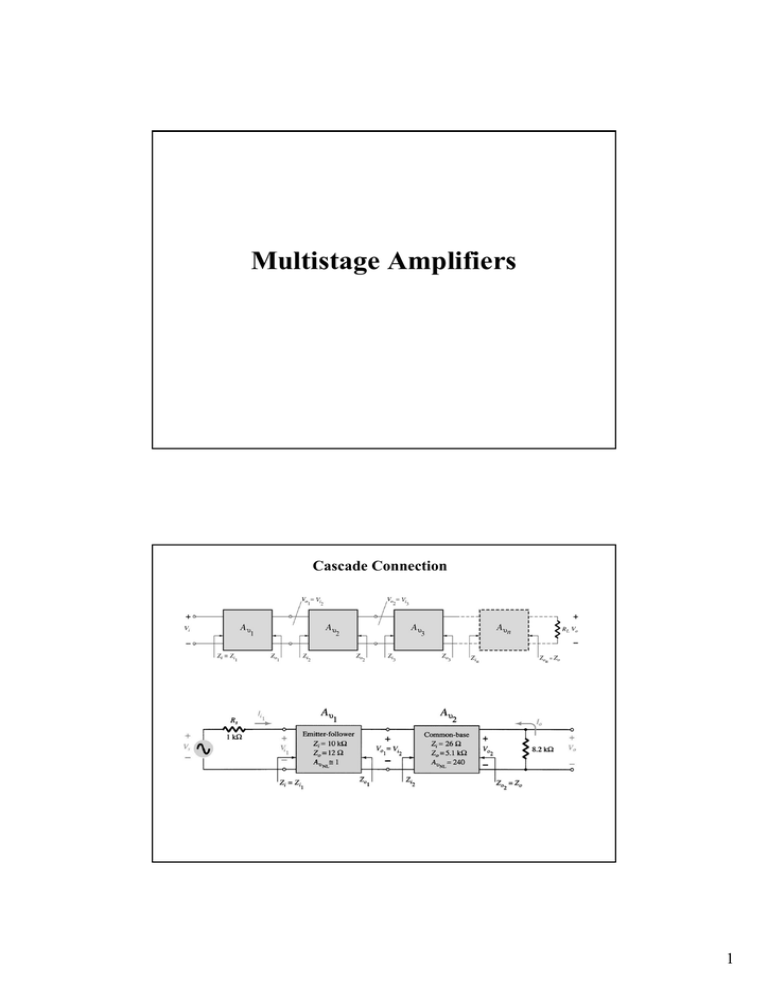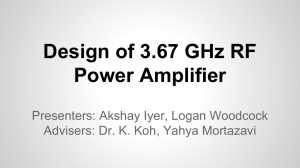Multistage Amplifiers
advertisement

Multistage Amplifiers Cascade Connection 1 AC Coupled Multistage Amplifiers The output of one amplifier is the input to the next amplifier. Note the DC bias circuits are isolated from each other by the coupling capacitors. The DC calculations are independent of the cascading. The AC calculations for gain and impedance are interdependent. The overall gain: with and 2 AC Coupled Multistage Amplifiers We can also express the overall gain as follows where FET Cascade Amplifier Voltage Gain: Input Impedance: Output Impedance: 3 BJT Cascade Amplifier Voltage Gain: Input Impedance: Output Impedance: Combination of FET and BJT Cascade A FET-BJT cascade is calculated in a similar fashion as a FET-FET or a BJT-BJT cascade. This combination provides a high gain from the BJT with the high input impedance from the FET. 4 Ex1: a) Draw AC and DC load lines for both transistors. b) Calculate the overall voltage gain AV = vo / vs. c) Find vs (max) which produces maximum undistorted output voltage. DC Coupled Multistage Amplifiers The output of one amplifier is the input to the next amplifier. Note the DC bias circuits are not isolated from each other The DC calculations are not independent of the cascading. Used either to amplify very low frequency signals or to amplify DC signals The overall gain: with and 5 Ex2: a) Draw AC and DC load lines for both transistors. b) Calculate the overall voltage gain AV = vo / vs. c) Find vs (max) which produces maximum undistorted output voltage. Ex3: a) Draw AC and DC load lines for both transistors. b) Calculate the overall voltage gain AV = vo / vs. c) Find vs (max) which produces maximum undistorted output voltage. 6 Ex4: b) Calculate the overall voltage gain AV = vo / vs. c) Find Ro. Cascode Connection This is a CE – CB combination. This arrangement provides high input impedance but a low voltage gain. The low voltage gain reduces the Miller Input Capacitance therefore this combination works well in high frequency applications. 7 A more elaborate version of cascode amplifier Ex5: VBE = 0.7V Consider the cascode amplifier above a) Find the voltage gain Av = vo/vi b) Find the input resistance Ri c) Find the output resistance Ro 8 Darlington Connection This combination provides large current gain, typically a few thousand. It has a voltage gain of near 1, a low output impedance and a high input impedance. Feedback Pair This is a two-transistor circuit that operates like a Darlington pair. It has similar characteristics: high current gain, voltage gain of near 1, low output impedance and high input impedance. Note: it is not the Darlington configuration: Darlington: 2 npn BJTs Feedback Pair: pnp driving an npn BJT 9



